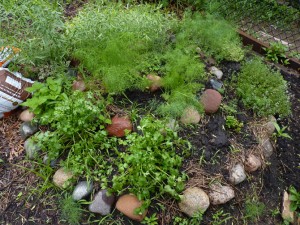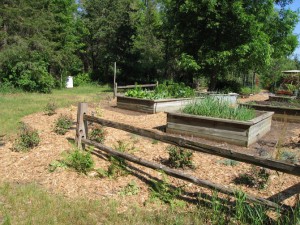Beltane New Moon (Hungry Ghost)
The potatoes have mounds around the growing plants and the hilled up earth from their trenches has leveled out. The bush beans I planted there last week  have begun to germinate and I plan to plant more bush beans tomorrow if the weather is ok.
have begun to germinate and I plan to plant more bush beans tomorrow if the weather is ok.
While checking fruit on our trees, I ended up weeding the blueberries, too. The clover is exuberant, mostly a happy addition to our orchard, but overwhelming in the blueberry patch. We do have apples and cherries and currants, but I could find no pears. Our production will at least double this year, maybe more. I counted six apples and several, say 8, cherries. The currants have experienced substantial predation, by birds, I think.
I mounded earth around the growing leeks, too, to blanch the stems. The garlic, which grows near the leeks, looked ready to harvest, but when I pulled a few out of the ground, they looked like they had a ways to go. I hung the five I dug from a bamboo pole in the honey house.
Kate’s begun weeding and that helps a lot. Keeping the bees, the vegetables, the orchard and the flowers in good shape requires attending to the plants we have, doing things like mounding the potatoes and the leeks, checking the garlic, watching for disease and insects, taking action if a plant seems to be in distress, replanting if, as in the instance of the carrots, germination is low. Though weeding is an important, very important maintenance action, it doesn’t involve direct plant care which is what I enjoy. I’m glad to have Kate back at the weeding. She’s also our pruner and she has begun to recover our front sidewalk.
Then it rained.

 Paula Westmoreland from Ecological Gardens came out today and gave us a walk through, explaining the plants and their relationships. The real distinctiveness of permaculture lies in developing and nurturing those relationships, using plants together in ways that are mutually beneficial. An easy to understand example is the familiar legume family, a group of plants that fix nitrogen in the soil. Since most plants deplete nitrogen in the soil, following a planting of a non-legume, especially if it’s a heavy feeder like, say, tomato or corn, with a legume helps restore the soil chemistry.
Paula Westmoreland from Ecological Gardens came out today and gave us a walk through, explaining the plants and their relationships. The real distinctiveness of permaculture lies in developing and nurturing those relationships, using plants together in ways that are mutually beneficial. An easy to understand example is the familiar legume family, a group of plants that fix nitrogen in the soil. Since most plants deplete nitrogen in the soil, following a planting of a non-legume, especially if it’s a heavy feeder like, say, tomato or corn, with a legume helps restore the soil chemistry.